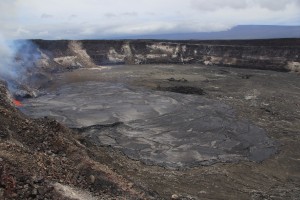Kilauea Summit Update – 4/30/15
Kilauea’s summit continues to show heightened signs of activity as its crater lava lake continues to go through inflationary and deflationary tilt occurrences. Hawaiian Volcano Observatory said Thursday morning that at around 4 a.m., a deflationary tilt at the summit began.
Over the past day, lava has neared or risen to the top of the crater, and in brief lava episodes, the lava has overflown onto the floor of Halema’uma’u Crater.
Along the south margin of the lava lake, HVO reports that spattering since Wednesday has been common.
At 12 p.m. Wednesday, the lava level had been measured to be about 2 yards from the floor of Halema’uma’u Crate. This morning, that measurement had dropped and is now several yards below the previous measurement.
Areas below Kilauea’s summit and upper East and Southwest Rift Zone continues to experience heightened seismic activity. In addition, HVO scientists say sulfur dioxide emission rates averaged 4400-5400 tonnes/day for the week, ending on April 28.
Aside from an inflationary tilt recorded by the tiltmeter on the north flank of Puʻu ʻŌʻō, no other changed at Puʻu ʻŌʻō have been recorded. HVO scientists say the sulfur dioxide emission rate from all East Rift Zone vents when they were last measured on April 28 was about 700 tonnes/day.
The June 27 lava flow continues to be observed by HVO officials through webcam imagery. The webcams show nighttime incandescence and daytime smoke that provides indication that the surface flows to the northeast of Puʻu ʻŌʻō continue to remain active.
On Wednesday evening, HVO noted that because of the behavior of the lava and its high and slowly rising levels of lava within the vent, the flows at the crater are likely to persist and continue to occur intermittently.
“During similar lava lake activity at Halemaʻumaʻu in the 1800s and early 1900s, lava lakes frequently produced overflows. Over time, overflows and intermittent spattering can build a collar of solidified lava that then contains the rising and circulating lava lake. This phenomenon is known as a ‘perched lava lake,” HVO said in Wednesday evening’s update.
In the Wednesday evening update, HVO explained the current Kilauea summit activity:
“The current activity is best explained by an increase in magma supply to the Kīlauea Volcano magma reservoir or storage system, something that has occurred many times during the ongoing East Rift Zone eruption. Increased supply and shallow storage can explain the higher magma column in the Overlook crater, as well as the continuing inflation and elevated earthquake activity in the summit region. Higher volumes of magma moving throughout the summit and upper East Rift Zone pressurizes the reservoir and magma transport system and causes small earthquakes and inflationary tilt.
“As long as magma supply is elevated, we expect continued high lava lake levels accompanied by additional overflows. Lava from these overflows could cover more of the Halemaʻumaʻu Crater floor, form a perched lake, or result in some combination of these two processes. Spattering or lava fountaining sources can migrate across the surface of the lava lake, as recently observed. We expect continued rockfalls, intermittent explosions and ash fall, and continued high levels of gas release.
“The evolution of unrest in the upper East Rift Zone is less certain. It is possible that a surge of lava will reach Puʻu ʻŌʻō and lava flow output will increase, both on the flanks and within the crater of Puʻu ʻŌʻō. It is also possible that lava will form a new vent at the surface. If this happens, it will most likely occur along a portion of the East Rift Zone between Pauahi Crater and Puʻu ʻŌʻō. Other outbreaks in the summit area or along either rift zone on Kīlauea cannot be ruled out. If a new outbreak or surge in lava to Puʻu ʻŌʻō occurs, we will expect a drop in the summit lava lake.”
BigIslandNow.com will continue to keep you updated on lava activity.

This is a labeled photo of the overflowing lava lake taken from the rim of Halemaʻumaʻu. The dashed white line indicates the lava lake rim. USGS/HVO photo.

This photo shows a view from the rim of Halemaʻumaʻu showing the lava lake in the completely filled Overlook crater. USGS/HVO photo.

Kīlauea Volcano’s summit lava lake, which was about 12 m (40 ft) below the vent rim on April 25 (left), overflowed the vent rim for the first time at about 9:40 p.m., HST, on April 28. As of noon on April 29 (right), the lava lake had overflowed the vent rim several more times. These Webcam images capture the summit vent before and after the overflows. USGS/HVO photos.
















